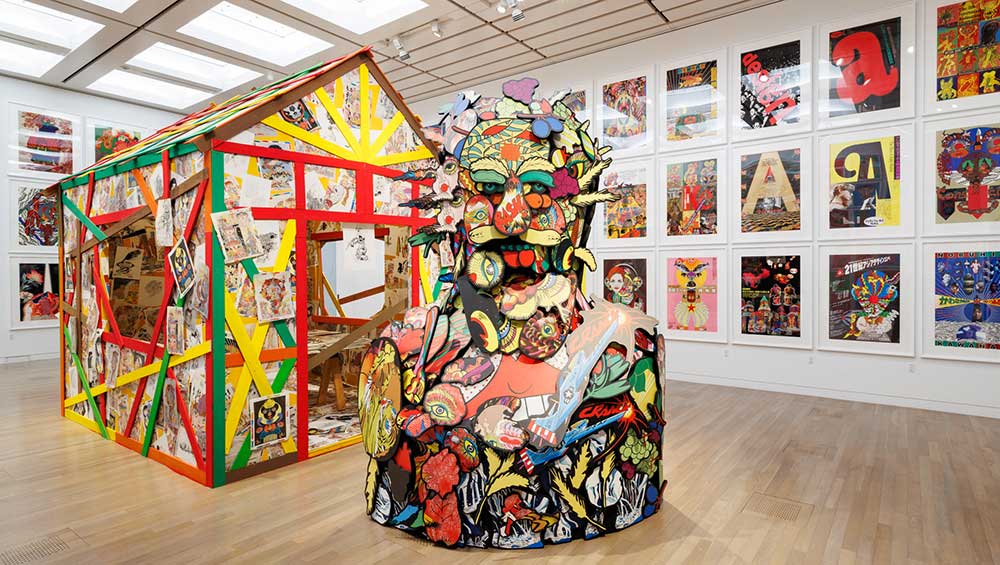
Keiichi Tanaami, Labyrinth of Arcimboldo, 2024. Installation view. © Keiichi Tanaami, courtesy of Nanzuka.
The National Art Center, Tokyo
7 August – 11 November 2024
by KANAE HASEGAWA
This exhibition, which takes the theme of memory, traces the entirety of Keiichi Tanaami’s career, which spanned more than 60 years, and is made all the more poignant because Tanaami died, aged 88, two days after its opening. The show includes more than 500 works.
The first room of the exhibition displays his latest work, A Hundred Bridges, which was created for this show and presents two interpretations of bridges. The first, a two-metre long, eight-part folding screen, shows a series of red bridges, undulating like mountains, in the manner of a landscape painting. The bridges are surrounded by multiple images cut from magazines: rivers, waves, waterfalls and glaciers fill the screen, and US fighter jets traverse the landscape. Tanaami, who said he had a horror of a vacuum, is known for his colour-saturated works in which every space is filled. The images include Disney characters that have influenced Tanaami since childhood, cutouts of 1970s American comic-book heroes such as Batman, blond female figures symbolising material culture, skeletons and imaginary creatures, all arranged without hierarchy. It is like Noah’s Ark turned upside down in the sea, and in a sense, the screen is a miniature of the world. The second work is a 3.5-metre-high installation of multiple bridges, over which various imaginary creatures are projected as if secular creatures are heading towards a sacred world. Tanaami took inspiration for A Hundred Bridges from the Edo period painter Hokusai Katsushika.
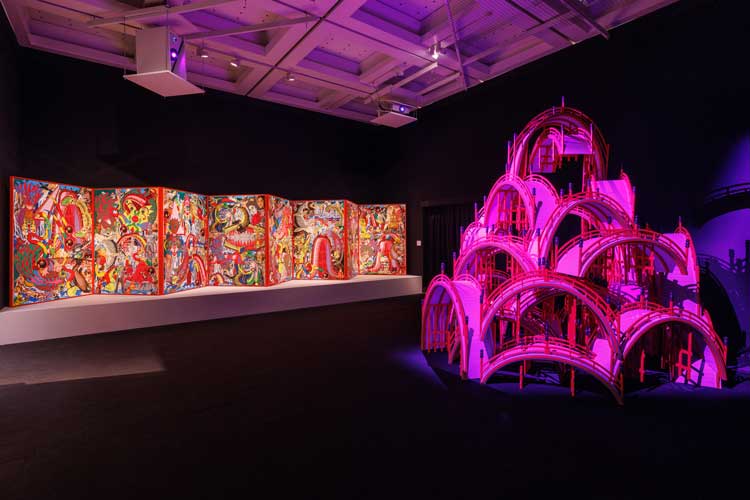
Keiichi Tanaami, A Hundred Bridges, 2024. Installation view. © Keiichi Tanaami, Courtesy of Nanzuka.
In the next room, we are guided through a chronological display of Tanaami’s activities over a 60-year period. Tanaami was born in 1936, the eldest son of a clothing wholesaler in Kyobashi, a central and commercial area in Tokyo. The first air raid on Japan by US Army Air Force in 1942 left a strong impression on the young boy. “My memories of the war at the age of four or five are very strong. B-29 Superfortresses would attack the mainland, and we would hide in air-raid shelters, but when we went outside, we would see charred and bloody corpses lying in the street. My mother would hold my eyes with her hand and hide them so I couldn’t see the atrocity, but I could see them through the gaps between her fingers. The strong impression of seeing this every day has stayed with me, and the fact that one day any one will die has been strongly rooted in my mind,” he said in an interview with the art historian Yuko Ikegami in August 2013.
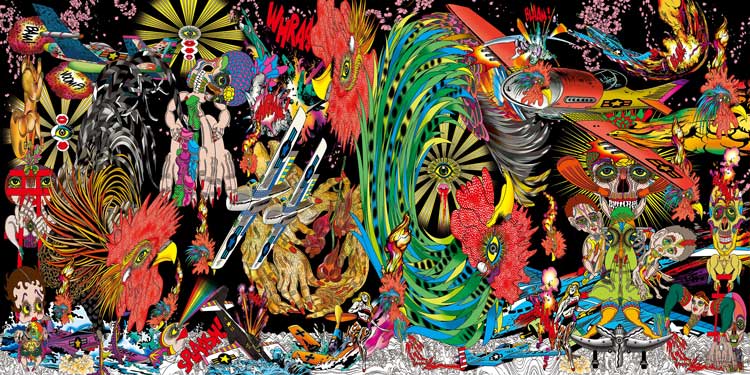
Keiichi Tanaami, The Story of Death and Rebirth, 2019. © Keiichi Tanaami, Courtesy of Nanzuka.
In 1944, Tanaami and his mother left Tokyo for Niigata Prefecture on Japan’s west coast, staying there until after the war. This meant he was not in Tokyo during the 1945 firebombing of the city, when Tokyo was burnt to the ground. Even though he was too young to understand what the war was all about, he instinctively felt horror seeing his mother’s terrified face every day. The experience and the atrocity of war seen on television or in the newspapers must have been jumbled together and overwritten as truth in Tanaami’s mind. In fact, his mother scolded young Tanaami when he spoke about running away during an air raid, saying: “What you say is not true.”
Although war is a major theme and motivation in Tanaami’s work, motifs of war and death were less apparent in his early work from the 1960s, when he began his career as an artist.
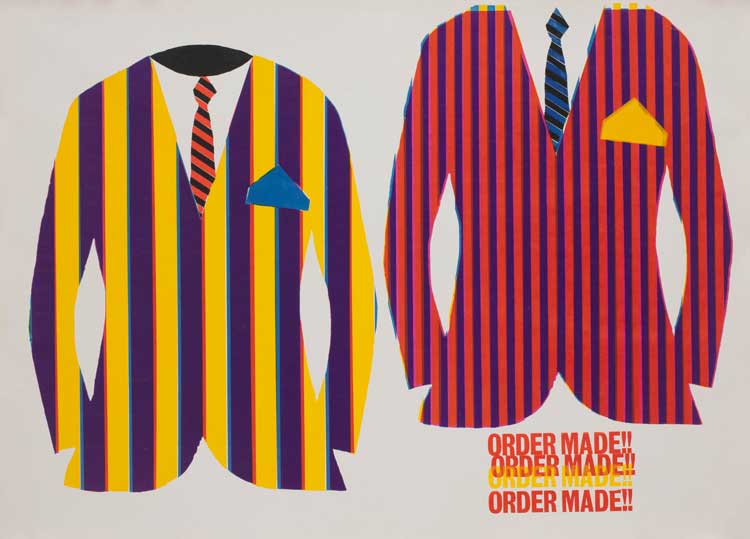
Keiichi Tanaami, Order Made!! Series, 1965. © Keiichi Tanaami, Courtesy of Nanzuka.
On display is a series of Tanaami’s early silkscreen prints. In Order Made!! (1965), the subject is not a made-to-order suit, but a readymade one that is mechanically silkscreened. Tanaami’s theory was that even with silkscreen prints, by devising a slightly different colour scheme and arrangement each time it was printed, each print became a work of art. These works were inspired by magazines featuring pop art that Tanaami saw in a bookstore in Ginza that imported foreign publications. Similarly, A Portrait of Keiichi Tanaami (1966), which takes the form of a printed pop art book, is a collection of portraits of a man wearing sunglasses. These are portraits of Tanaami himself superimposed on images of unidentifiable male figures wearing sunglasses or images of Superman and Batman. Surrounding them are naked female figures in the style of Aubrey Beardsley. These depictions illustrate the fact that Tanaami didn’t have a style of his own but was influenced by others. In fact, he once said: “I don’t think my work has originality. I am always creating, borrowing and appropriating from something.”

Portrait of Keiichi Tanaami. © Keiichi Tanaami, Courtesy of Nanzuka.
The biggest influence on Tanaami was the American culture he was exposed to as a child and a young man. Comics, a part of US culture that came with the military occupation after the war, inspired the young artist. The occupying forces made boys carry out tasks such as moving debris and they sometimes gave them food, such as chocolate, as payment for their labour. At a time when there was no food and the entire nation was starving, US soldiers who offered life-saving food must have seemed like saviours to the young Tanaami: at the same time, he must have felt uncomfortable receiving charity from the US military, which had taken the lives of so many Japanese people and occupied their land. In addition, to US comics, the young Tanaami was also inspired by Disney’s moving animation. Tanaami enrolled at the design department of Musashino University of Art and, after graduating in 1958, became a successful graphic designer for an advertising agency.
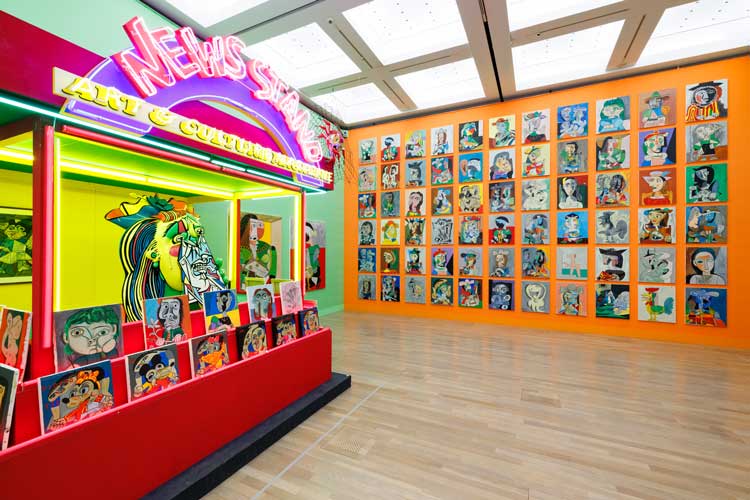
Keiichi Tanaami, Pleasure of Picasso – Mother and Child Series, 2020-23. Installation view. © Keiichi Tanaami, Courtesy of Nanzuka.
In 1970, Tanaami’s first visit to the US would shape his attitude to art: the golden 1950s was long gone and the affluent and strong America that Tanaami had seen as a boy was a thing of the past. Instead, Tanaami came across the anti-Vietnam war movement and the civil rights movement. The country was struggling with the gap between ideals and reality, with a hippy culture opposed to US imperialism, and with the increasing illegal trade of marijuana. Tanaami’s mind was like a crucible in which various elements were mixed as he witnessed this dichotomy in the US. He bought magazines and other materials dealing with nudity, a product of the sexual revolution in the US, and brought them back to Japan, where he began to cut out photographs and images and superimpose them on his own painted images to create the collages that became his leitmotif. Collage was the perfect way to express what was happening in Tanaami’s mind. In addition, in 1975, he became the first art director of the Japanese edition of Playboy, where he stayed until 1986. It was this job, laying out pages with photographs and articles, that helped him to hone the technique of collage.
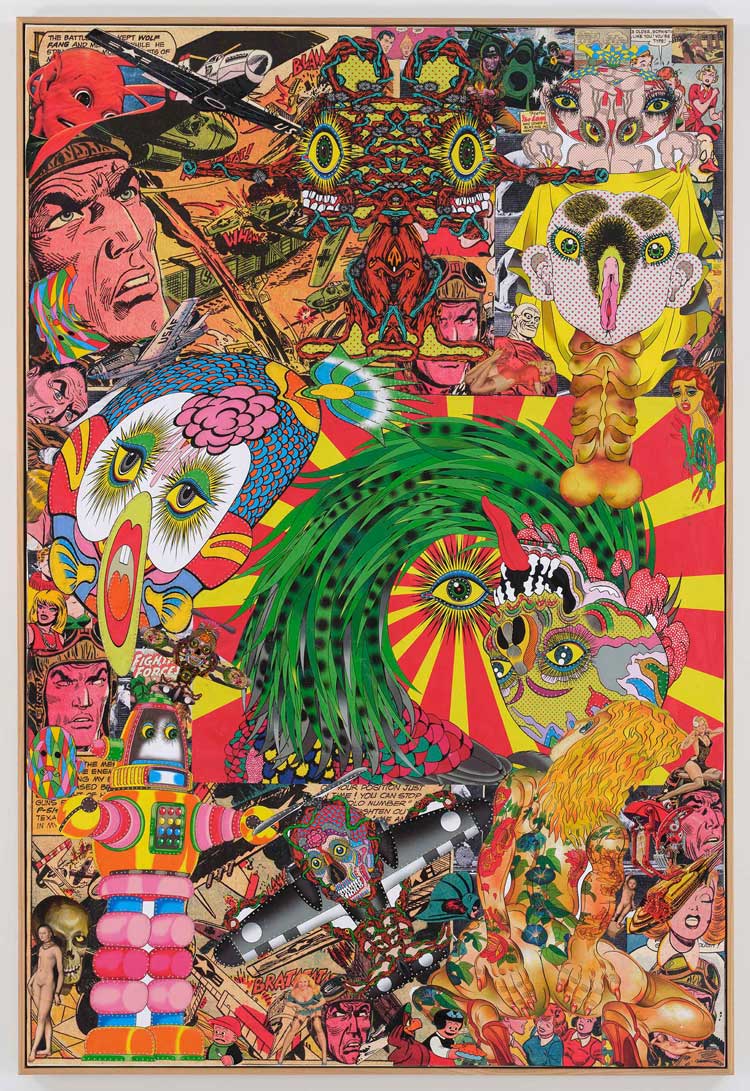
Keiichi Tanaami, Presence, 2022. © Keiichi Tanaami, Courtesy of Nanzuka.
In addition to the overwhelming number of pictures crammed into Tanaami’s works, it is his use of striking colours, such as shocking pink and turquoise blue, that astonishes the viewer. It is likely that he first felt the magical appeal of rich colours as a boy, when he was surrounded by the Kimono textiles that filled his grandfather’s store. Explaining the use of colour in his work, Tanaami also recalled: “After the war, when I returned to Tokyo, the contrast of a red burnt field and a bright blue sky was so striking.” Tanaami’s colourful works are probably like landscapes within his mind.
At the time that Tanaami worked on Playboy, it combined journalism and entertainment and sold about one million copies a month. He was inundated with work and, as a result, he became ill. In 1981, he was diagnosed with tuberculosis and spent four months in hospital. He had hallucinations due to the effects of strong medication, which made the pine trees he could see from his hospital room window appear distorted, like the world of a Salvador Dalí painting. He thought he had really looked out at the pine trees, but the nurse told him he had been sleeping like a log. Tanaami was intrigued by this and went on to draw what his hallucination had brought to mind. The image of the distorted pine tree is a motif that appears several times in his later works, as can be seen in his Tokiwa-matsu series (1986-87) and in his borrowing of some of Lucas Cranach’s paintings. The deformed and incomprehensible forms of the strange creatures in Tanaami’s work were based on images that had come to him in his hallucinations. After a life and death struggle with illness, and after his war experiences, he started to face death as an impending issue. From the 1980s onwards, images relating to war and death, which had not appeared in his early years as an artist, began to appear more frequently. The deformed and unrealistically coloured goldfish in his works are based on his memories of the goldfish kept in Tanaami’s grandfather’s house during the war, when their eyes were illuminated by flare bombs and emitted a strange light. Among these motifs related to war and death, bridges have often been depicted as a link between the living world and the afterlife.
We can’t experience the trauma or the feeling of those who have gone through war, or those who have had hallucinations. However, Tanaami has shown his artistic genius in turning these horrific war experiences into creative works, rather than trying to extinguish those horrors. Shinji Nanzuka, founder and the head of the gallery Nanzuka in Tokyo, who has been working closely with Tanaami since 2006 says: “The grotesqueness of Tanaami’s work can be described as a visualisation of Japan at that time. His works created over the past 60 years may be a journal of Tanaami’s vision of Japan’s place in the world.”